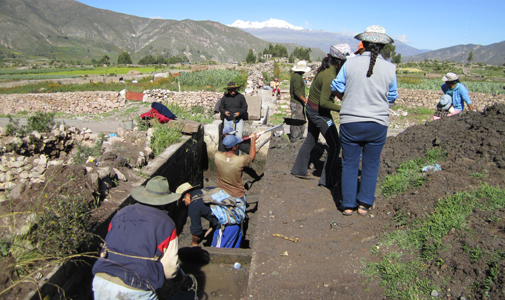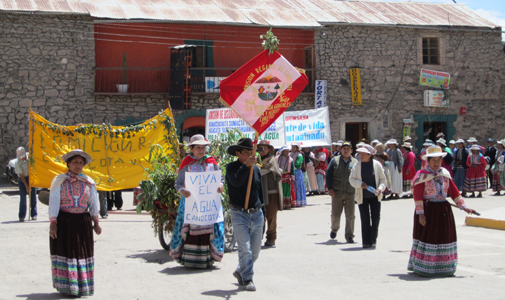Astrid Stensrud
May 2011
On 12 May 2011, representatives of the 31 water commissions (comisiones de regantes) in Colca valley were gathered in a meeting in Chivay, a town in the upper end of Colca Valley and capital of Caylloma province (Arequipa region, Southern Peruvian Andes). The water commissions are the local organizations of small scale farmers, which have the responsibility of distributing water for irrigation, as well as operating and maintaining the infrastructure of water. The purpose of this meeting was to discuss and democratically decide how to distribute the two million soles which the regional authorities in Arequipa had promised to the Water Users' Council of the Colca Valley (la Junta de Usuarios - Valle del Colca). This Junta represents the 31 local commissions, and their central office is located in Chivay.
One week earlier, I accompanied the Junta and the leaders of the commissions to Arequipa, where we made a protest march, reclaiming money which the authorities owed them. The regional government had promised to give 600 000 soles each year to each Junta in the region, but had not fulfilled this agreement since 2009. The water users in Colca, who are small scale farmers, are tired of broken promises. Moreover, their present economic situation is precarious due to this year's bad weather conditions: after years of drought, the rains in February and March 2011 have been terribly strong and destructive. The rains have destroyed roads and bridges, water reservoirs, dams, water intakes and water channels. Moreover, the frost arrived three months earlier than usual, destroying the harvests and killing alpacas and llamas in the highlands. People talk about climate change and are concerned about the consequences. The seasons are destabilizing: there is frost in the rainy season and rain in the dry season, altering the normal agricultural cycle. People say that the earth gets warmer and needs more water than before. Each year they see less snow on the mountain tops, and the water level in the natural sources, which they call ‘water eyes' (ojos de agua), is diminishing.

One solution to the problem of water scarcity is to improve the infrastructure which leads the water from the sources to the fields. However, that costs money, and money is scarce after the failed harvests. After having made the protest march in the town square of Arequipa, a delegation had a meeting with the president of the region, who promised to give the money that the region owed to the Junta of Colca Valley. Therefore, on 12 May, the commissions were discussing how they should use this money: what are the priorities? Each local commission has special needs: reservoirs or channels in need of repair. Moreover, the central office of the Junta needs equipment of topography and a jeep to get around. The projects of building water infrastructure in four committees were chosen as worthy of financing, and the rest of the money would be distributed equally among the rest of the committees. The central board decided that they wanted to give priorities to the commissions where all the water users had paid the corresponding tariff. In order to get money, the committees should have fulfilled their duties of paying the water tariffs.
By working with the Junta, I get first hand insight in the economy and politics of water management. Sitting in their office, I meet the representatives of the committees in the valley, who come to see the engineer who runs the Junta on a daily basis, together with an accountant and a secretary. Some seek advice concerning a local water conflict, some need information about the paper work to get a water license, and others apply for support to build a new water channel or a micro-dam. Sometimes, I accompany the engineer to meetings and inspections in the villages. There are different kinds of problems of small and large scale: water thefts, water users not paying their water tariffs, technical problems of infrastructure, and conflicts with mining companies who drain the natural water sources and contaminate water. An important guideline in the solution of conflicts is the new water law. However, the members of the local commissions, as well as the employees of the Junta, are just beginning to learn and understand the changes that the new law implies and how they may adjust the law to the local realities.
Before arriving to Chivay, I thought that I would have to dig for information. I soon discovered that, on the contrary, water and climate are issues on the surface of most people's mind. Actually, there are so many events and activities concerning water taking place all the time that it is impossible for one anthropologist to cover it all. In the area of irrigation water, there are several state institutions working on different levels of authority. The commissions and the Junta are non-profit civil associations. There is also an irrigation project financed by the World Bank, which is starting to operate in Colca Valley, introducing ‘modern' irrigation technology. Then there is Autodema, the institution managing the Majes Channel which leads water from the Colca River to the large scale export oriented agriculture in the desert.
In the area of water for human consumption, the main actors are the local state administration of drinking water, the Ministry of Health, the municipality, a civil association fighting to regain the local management of drinking water, the housing association of a neighbourhood where they lack access to clean water, and a NGO financing projects to ensure safe drinking water in the communities. The multiplicity of actors - both institutional (state, civil society, NGOs) and nonhuman water bodies and control mechanisms (dams, reserves, intakes, channels, tubes, valves, measuring devices) - make up a complex web of relations, and it can be hard to grasp the full picture. However, although different actors may have different perspectives and priorities, they all agree that water is a resource that each day is becoming more scarce and valuable and worth fighting for.

This was reflected by the slogans of the World's Water Day, which was celebrated in Chivay on 22 March with a ‘sensitization march' and a seminar about climate change (which was an incredible gift for an anthropologist concerned with water and climate - I was truly in fieldwork heaven that day). While marching around the town square, water users from the 31 commissions in the Colca Valley shouted: ‘The water should not be sold - the water should be defended.' (El agua no se vende - el agua se defiende), and ‘Water is life. Long live the water!' (El agua es vida. ¡Que viva el agua!)
Astrid Stensrud
